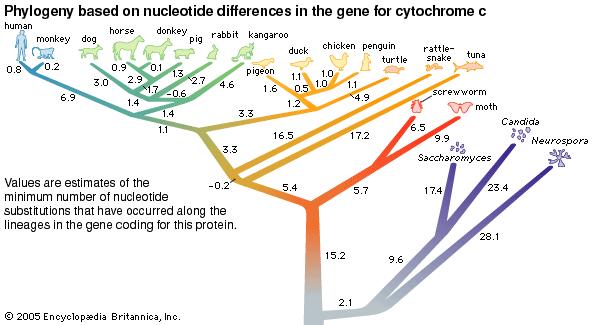Phylogenetics
Phylogenetics is the study of evolutionary history, achieved by analysing the molecular sequences of individual organisms[1]. It tells us how different organisms are related to each other by their evolutionary history and thus, how they have descended from one another; this branch of phylogenetics is known as phylogeny. Fundamental to phylogeny is the universally accepted belief that all organisms originally descended from a common ancestor (LUCA - last universal common ancestor.)
Evidence for phylogeny comes from various sources. These include analysis of DNA sequences, comparative morphology/anatomy (homology) amd paleontology (analysis of fossils.)
Analysis and comparisons of DNA sequences can involve looking for nucleotide differences in a particular gene. For example, DNA sequences can be examined for any nucleotide mutations in the gene coding for cytochrome-c (a protein found in almost all living things.)

The fewer the nucleotide differences in the sequence, the more closely related the organisms are to each other. One way in which genomic sequences can be observed is through Phylogenetic Footprinting[2]. This is where regulatory sites on DNA are identified, allowing comparative genomics between closely related species; this process is very efficient at identifying DNA sequences controlling gene expression.
The study of phylogenetics is best represented by phylogenetic trees. These effectively present phylogenetic findings in a visual form. Different phylogenetic trees can be integrated in order to produce the most accurate representation of the evolution of modern life forms[3]. The most famous phylogenetic tree is the Universal SSU rRNA Tree of Life. This tree states that there are 3 domains of cellular life - Bacteria, Archaea and Eukarya.
References
- ↑ Daniel L. Hartland, Elizabeth W. Jones (2009) Genetics: Analysis of Genes and Genomes, 7th edn., Sudbury, Massachusetts: Jones and Bartlett Publishers.
- ↑ Alberts, Johnson, Lewis, Raff, Roberts, Walter (2008) Molecular Biology of the Cell, 5th edn., New York: Garland Science, Taylor & Francis Group.
- ↑ Alberts, Johnson, Lewis, Raff, Roberts, Walter (2008) Molecular Biology of the Cell, 5th edn., New York: Garland Science, Taylor & Francis Group.